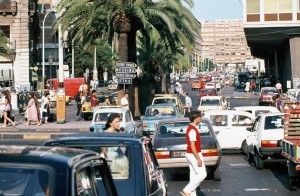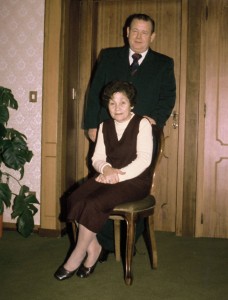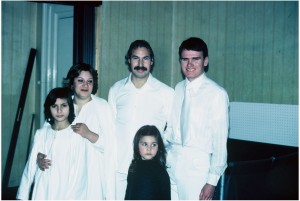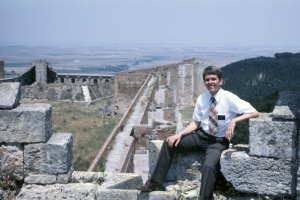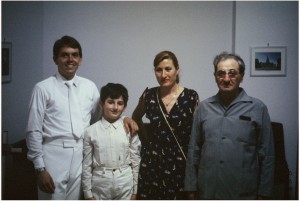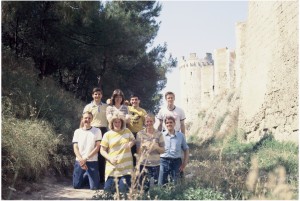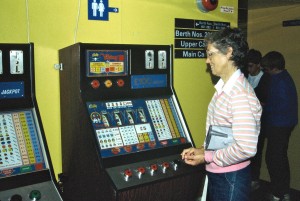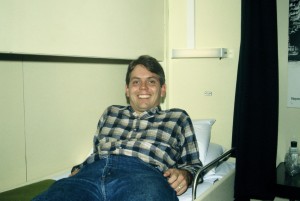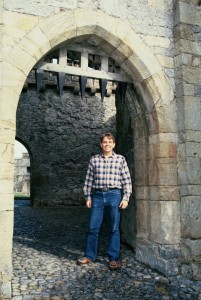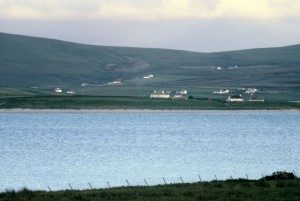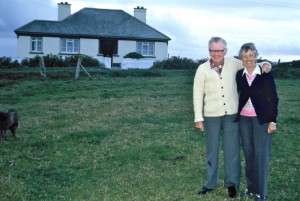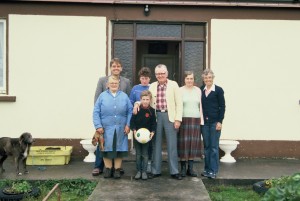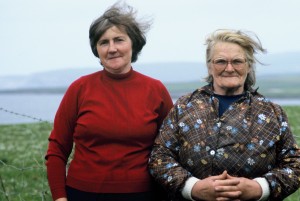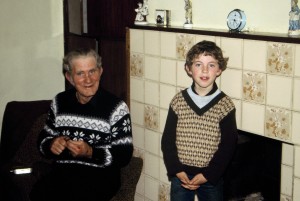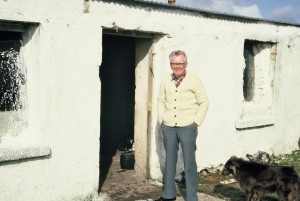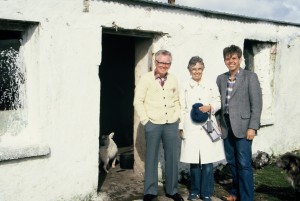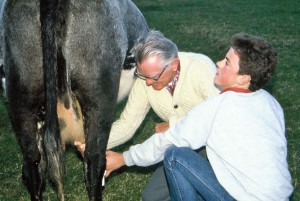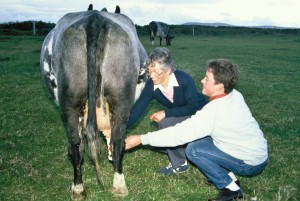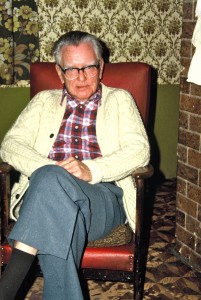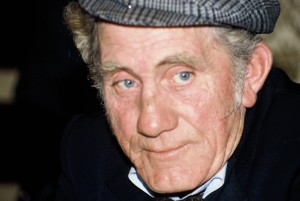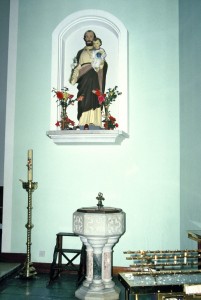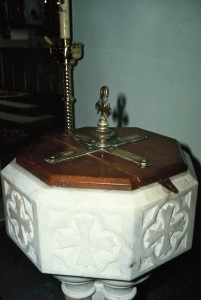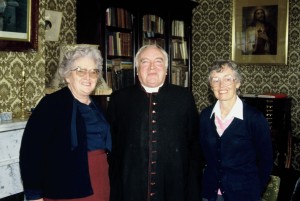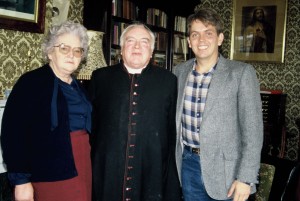I was the first Latter-day Saint missionary in my family. My call took me to the Italy Catania Mission, which included the boot of Italy, the island of Sicily, the smaller islands around Sicily, and the island of Malta. The Italy Catania Mission ceased to exist on July 1st 2010 when it was merged with the Italy Rome mission.
When I served the island of Malta was closed to missionary work and none of the little islands or small towns had missionaries. All of these photos came from other Elders or Sisters since I hadn’t brought a camera on my mission.
The flights from Salt Lake City to Italy Catania took about 25 hours with layovers between flights. We checked out at 5 a.m. from the Missionary Training Center, and they drove us to the Salt Lake City Airport. We waited a couple hours before our flight to Denver, Colorado. There we waited a couple more hours for our flight to New York’s Kennedy Airport. We took off from Kennedy on a Pan Am flight to Rome, Italy. We arrived the next morning, and waited almost six hours before our next flight. The last flight went from Rome to Catania, and we were exhausted.
While we didn’t know that the airport was under construction, we landed at what appeared to be an old military airbase.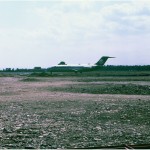 There was no terminal. We went through customs and retrieved our baggage in what appeared to be an 18th century villa. There was a modern airport in Catania when I completed my mission. The photo to the left was taken of a plane taxiing as ours did in October 1980. The mission office personnel picked us up in an old Volkswagen bus and drove us to Catania. They took us through the narrow scenic gate that dates from the 17th century. They then deposited us in a pensione where we could get some sleep.
There was no terminal. We went through customs and retrieved our baggage in what appeared to be an 18th century villa. There was a modern airport in Catania when I completed my mission. The photo to the left was taken of a plane taxiing as ours did in October 1980. The mission office personnel picked us up in an old Volkswagen bus and drove us to Catania. They took us through the narrow scenic gate that dates from the 17th century. They then deposited us in a pensione where we could get some sleep.
The next day we walked down to the mission home. The photo above looks straight down Corso Sicilia where the mission headquarters was located. The large palazzo (apartment building at the end of the street is where the mission president lived on the 9th floor.
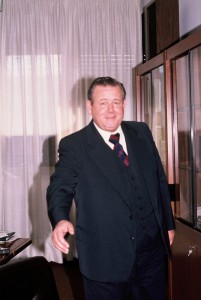 My mission president was Lino Pablo Gambarotto. He was a wonderful man who served with great diligence. He was beloved by the members. President Gambarrotto was born in Italy but grew up in Argentina where he converted to the church. The image to the left was virtually the same for all Elders and Sisters who arrived in the mission when President Gambarotto presided over the mission. President Gambarotto would say, “Benvenuto, Anziano.” or “Sorella.”
My mission president was Lino Pablo Gambarotto. He was a wonderful man who served with great diligence. He was beloved by the members. President Gambarrotto was born in Italy but grew up in Argentina where he converted to the church. The image to the left was virtually the same for all Elders and Sisters who arrived in the mission when President Gambarotto presided over the mission. President Gambarotto would say, “Benvenuto, Anziano.” or “Sorella.”
The next photograph is the official mission picture of President and Sister Gambarotto. It was taken in their apartment. They were a wonderful couple and President and Sister Gambarotto took quiet and personal ownership of all the missionaries. They served all of us with great grace and comfort.
The in-processing at the mission home was a whirlwind. After the mission home, we went to the President’s apartment for dinner at 2 p.m. in the afternoon. There we met missionaries on their way home and saw a slide show about the mission. After the slide show missionaries who served in our assigned cities told us where we would first serve in the mission field. I felt blessed to only have to drive a short distance to my first city, which was the same city as the mission home. I was exhausted for several days. Elder Harrison took the photo the second day I was in the district before we went out to do missionary work.
I felt blessed to only have to drive a short distance to my first city, which was the same city as the mission home. I was exhausted for several days. Elder Harrison took the photo the second day I was in the district before we went out to do missionary work.
My first assignment was to the mission home city of Catania. I had a wonderful companion named Elder Stewart. He was an avid hockey fan, which seems to be the rule across Canada. He came from the Ontario province of Canada.
I had a wonderful companion named Elder Stewart. He was an avid hockey fan, which seems to be the rule across Canada. He came from the Ontario province of Canada.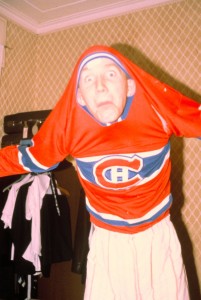 The photograph on the left was taken one evening after working hard all day, while the one on the right was taken on All Hallows Eve (Halloween) after we got soaked waiting for buses that never came. Buses often didn’t come when the drivers called a strike, which seemed to be a weekly occurrence sometimes.
The photograph on the left was taken one evening after working hard all day, while the one on the right was taken on All Hallows Eve (Halloween) after we got soaked waiting for buses that never came. Buses often didn’t come when the drivers called a strike, which seemed to be a weekly occurrence sometimes.
A major requirement was to pass-off all of the missionary discussions word-for-word. I studied hard to accomplish that. Elder Stewart took the picture of me studying the discussions in early November 1980. I hadn’t quite got them all done before Elder Stewart was transferred to Bari.
Elder Shupe replaced Elder Stewart. We worked together for two months when he went home having served his two years. The following picture is the Catania District 1 and it was taken new years day 1981 from the top of the building where the President and Sister Gambarotto resided.
After Elder Shupe went home, my new companion was Elder Bartlett. He had just been released as Branch President in Lecce. The third week we found Giuseppe Privitiera. We taught him for 5 weeks before he, his wife, and oldest daughter were baptized. It was the week that I was transferred to Foggia.
April 1981 transfers brought two departures from the Foggia District. My companion Elder Tenney was transferred to Bari.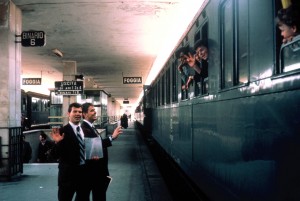 Elder Smith’s companion was also transferred but I don’t recall where he went. Elder Smith and I are waving from the platform as the train prepares for departure (Elder Oaks took the photo). Elder Potter came the next day as my new companion and Elder Thomas became Elder Smith’s new companion. I believe Elder Neumann took this photograph.
Elder Smith’s companion was also transferred but I don’t recall where he went. Elder Smith and I are waving from the platform as the train prepares for departure (Elder Oaks took the photo). Elder Potter came the next day as my new companion and Elder Thomas became Elder Smith’s new companion. I believe Elder Neumann took this photograph.
While serving in the city of Foggia, we had responsibilities to teach in the city of Lucera, Italy.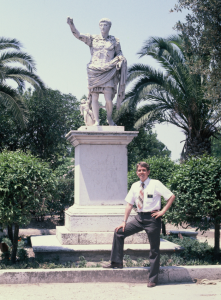 Lucera is an old Estruscan city. We took turns teaching there one day a month for each companionship. It cost almost 10,000 lira for a round trip for bus fare to and from the city. My companion, Elder Potter, took the photograph of me standing next to one of the two remaining statues of Augustus Caesar in Lucera. We climbed the walls in May 1981 because we had a couple hours after our appointments and couldn’t tract during the Italian siesta. Italians schedule lunch from 2 p.m. until 5 p.m., and tracting doesn’t work too well until after about 7 p.m.
Lucera is an old Estruscan city. We took turns teaching there one day a month for each companionship. It cost almost 10,000 lira for a round trip for bus fare to and from the city. My companion, Elder Potter, took the photograph of me standing next to one of the two remaining statues of Augustus Caesar in Lucera. We climbed the walls in May 1981 because we had a couple hours after our appointments and couldn’t tract during the Italian siesta. Italians schedule lunch from 2 p.m. until 5 p.m., and tracting doesn’t work too well until after about 7 p.m.
Elder Potter took the preceding picture of me on the parapet of the Hohenstaufen Castle in Lucera. It was built by the House of Hohenstaufen, or by the Holy Emporer Frederick the II in the thirteenth century.
We had the opportunity to baptize Elio Constantino on 17 June 1981. It was interesting that we received permission to baptize him because his parents weren’t ready for baptism.
His parents were baptized later in the year. His mother was baptized in November and father was baptized in December. I didn’t get back to Foggia during my mission but stopped their three years later to check on them.
We went back as a district to Lucera on a preparation tourism day. It was 2 July 1981. It was after transfers and Elder Oaks had gone to Trapani, which was about as far as you could go for a transfer. Foggia was the second most northern city and Trapani was the western most city on the island of Sicily.
We took this photo on the east wall of Hohenstaufen Castle. The turret in the background is where Elder Potter shot the previous photo of me.
I was transferred to Palermo on 16 July 1981. It was more than a 1,200 kilometer transfer. A train from Foggia to Bari, another from Bari to Reggio Calabria, a ferry across 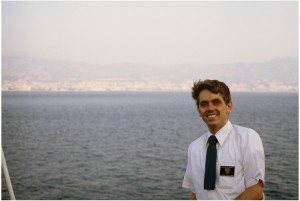 to Messina, and another train from Messina to Palermo. I left Foggia a little after 3 P.M. and got to Reggio Calabria at about 6 A.M. the next day. The picture is of me on the ferry crossing with Messina in the background. I still had more than six hours before I’d get to Palermo. I arrived in Palermo 17 July 1981, and had a memorable taxi ride where the driver wanted a thousand lira per bag plus my fare.
to Messina, and another train from Messina to Palermo. I left Foggia a little after 3 P.M. and got to Reggio Calabria at about 6 A.M. the next day. The picture is of me on the ferry crossing with Messina in the background. I still had more than six hours before I’d get to Palermo. I arrived in Palermo 17 July 1981, and had a memorable taxi ride where the driver wanted a thousand lira per bag plus my fare.
My companion (Elder Parry) and I had the blessing of baptizing the first Sicilian member’s father into the church. He was 85 years old at the time of his baptism into the Church and a veteran of WWI. His name is Bernardo Giurintano. Unfortunately, Bernardo’s son is no longer a member of the church but his grand children are active members of the Palermo Branch. Bernardo was baptized on 26 July 1981 by my companion Elder Parry.
On August 12th, the zone leaders told me I was being transferred to the mission home as the supply manager.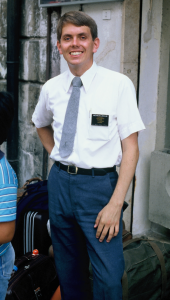 The photo to the right was taken on August 13th (my father’s sixtieth birthday) while I was waiting for the bus to Catania (taken by Elder Parry my companion). Fortunately, he provided me the original slide rather than a copy. Many of the copies that I had made during my mission turned out to be a bit blurry, which I didn’t really notice until they were digitized.
The photo to the right was taken on August 13th (my father’s sixtieth birthday) while I was waiting for the bus to Catania (taken by Elder Parry my companion). Fortunately, he provided me the original slide rather than a copy. Many of the copies that I had made during my mission turned out to be a bit blurry, which I didn’t really notice until they were digitized.
Unlike the almost five hour train trip from Messina to Palermo, I took the bus from Palermo to Catania. It took only two and half hours and was air conditioned. Such a superior arrangement to the train stopping at every small village without any air conditioning.
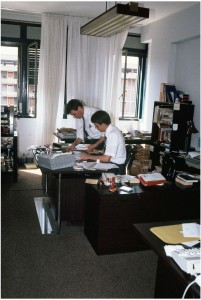 As soon as I got to the mission home, my training began. It took a month to learn my new responsibilities as the supply manager and assistant financial secretary. The following is a photo of my office with Elder Bingham teaching me my new job.
As soon as I got to the mission home, my training began. It took a month to learn my new responsibilities as the supply manager and assistant financial secretary. The following is a photo of my office with Elder Bingham teaching me my new job.
